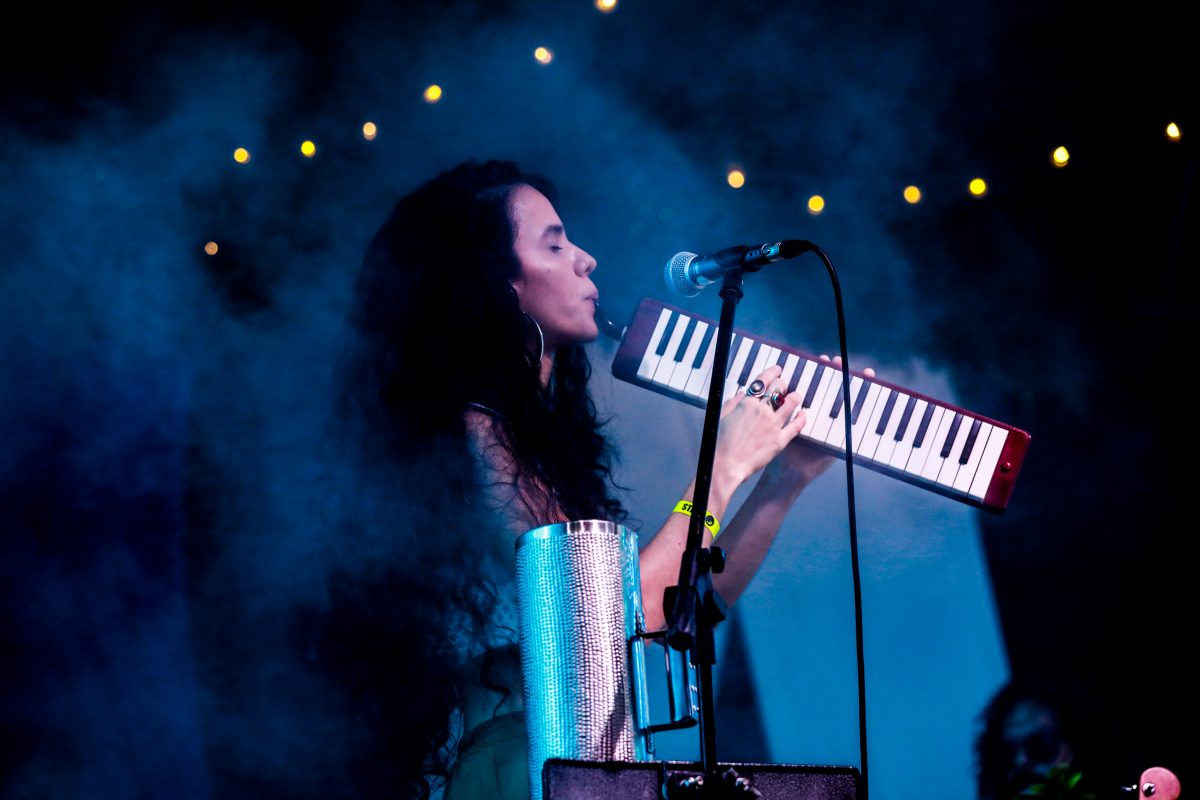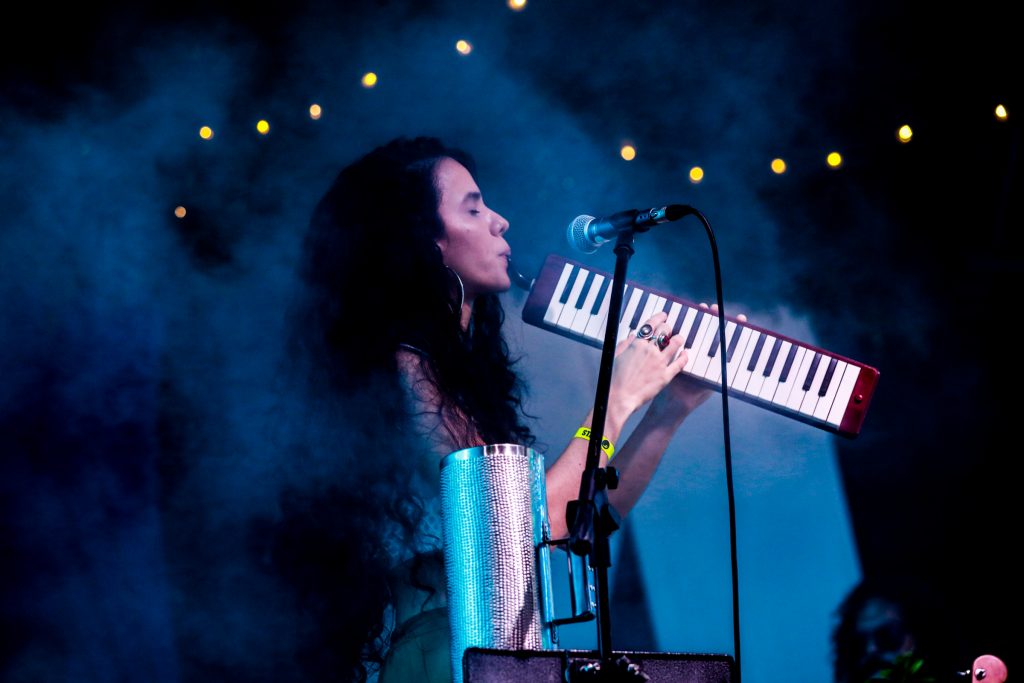Roots and folkloric music have never been missing from the Dominican music scene. For decades, groups like Palo Monte and Enerolisa y Su Grupo de Salve have embraced folkloric sounds, while other artists like Xiomara Fortuna, José Duluc, Rita Indiana, and Irka Mateo have creatively blended roots music with contemporary genres. One of the greatest musicians in the country, the late Luis Días, began his celebrated career playing folkloric music with the group Convite, setting the stage for a new movement of artists to be inspired in the future.
These are musicians who elevate and reclaim black heritage, defying white supremacy and the history of slavery, colonialism, and even periods in the 20th century when these genres were cause for persecution in the Dominican Republic. Some of the local sounds that have influenced these artists include salve, sarandunga, palos, gagá (known in Haiti as rara). Most of these genres are percussion-based, and feature instruments that come specifically from the Dominican Republic, like the güira.
To this day, roots music is still central to Dominican culture, and with an underground movement that is buzzing across the island, artists who push boundaries by colliding local sounds and modern genres are thriving. Artists like Rita Indiana, Carolina Camacho and Riccie Oriach have become local favorites, and a new generation of musicians following in their footsteps has started to emerge.
Henry Gonzalez, founder of the arts collective Kiskeya Libre, says that this is part of a legacy that must be upheld and protected. “When I started Kiskeya Libre with my team, I knew about Dominican folkloric music, yet I didn’t understand that the alternative [folkloric] scene existed,” he says. “I’ve been amazed by the alternative folkloric movement because this movement is about self-love; it’s about finding yourself in your past; it’s about the value of tradition and how the knowledge of tradition keeps us safe, but traditions don’t have to stay the same for us to hold that power – they can be intentionally transformed with a purpose while still preserving our legacies.”
Kiskeya Libre, a collective that seeks to connect artists across the diaspora, has worked with some artists who are part of the folkloric scene. “Even those people who grow up here, they still have the need to protect these rhythms, this music, and share that legacy to the world, and for me that’s our legacy of resistance and survival.”
Documenting this movement on a day like today is essential. In case you didn’t already notice from the Dominican flags flooding your timelines, it’s Dominican Independence Day. The date marks a complicated historical moment, when the country separated itself from Haiti in 1844, but it stands out as a time when Dominicans can play merengue without headphones on the subway, carry plantains in high school hallways, and embrace the spirit of celebration that is central to Dominican culture. In the Dominican Republic, the end of February is also when Carnival ends with a bang. To mark the end of Carnival, some of the leading figures and upstarts joining the folklore movement in the Dominican Republic came together for this fire collaboration under the moniker Sonido Fresko.
Sonido Fresko is one of the first collaborations to uplift this group of artists, each of them showcasing their own unique style. The movement is also spreading outside of the Santo Domingo scene, with artists making waves in the diaspora. Whether it’s fusing palos with rock, or playing more traditional genres with lyrics that reflect today’s political realities, get to know the artists who are giving new life to Dominican folk music.
Update 2/28/2018 10 a.m.: This piece has been updated to clarify a quote from Kiskeya Libre founder Henry Gonzalez.
1
Marimba
Marimba is a singer and composer hailing from Santo Domingo. The up-and-coming young artist’s sweet vocal style will cradle you through the roots music that has defined the country’s folkloric scene. Here she pays homage to the OG Luis Días with a cover of “Guardia del arsenal,” in a video where she plays all the instruments in the song. While Marimba’s musical career is just kicking off, her talent has already led her to sing alongside greats like Xiomara Fortuna, and more recently the Puerto Rican singer Calma Carmona.
2
Yasser Tejeda & Palotré
Through nonstop live performances from El Barrio to Brooklyn, Yasser Tejeda and Palotré have built a loyal following in New York City. They are an Afro-Dominican band fusing salve hymns, gagá, and palos with rock, jazz, and blues. The group’s repertoire continues to grow; Tejeda has toured with Prince Royce and worked alongside Irka Mateo. Catalog standout “Salve Eléctrica” nods to jazz, while “La Yola de Luis Terror Días” is a more lively rock number.
3
Nikola
Nikola kicked off her career singing back up for groups like Alex Ferreira & El Frente Caribe. Just last week, she released the video for her first solo single “Ola de la Mar.” With drums and guitar strings, the song follows the pattern of a familiar salve, though very subtly. The bilingual track kicks off with her singing “stop spitting me out,” before she dives into the Spanish-language chorus. She has also penned odes to Luis Días, performing a sweet take on his single “Marola” and taking its listeners on a nostalgic trip.
4
Estación Sub_Trópico
Estación Sub_Trópico is where Dominican roots rhythms and house find a home. A project helmed by folks involved with Mediumship Music, who collaborate with many local bands, Estación Sub_Trópico’s live set blends traditional Dominican sounds with electronic beats. Described as “un performance que resalta lo criollo, las raíces y el sonido de nuestra tierra y su cultura,” their DJ sets will take you through a journey across the island. Often, they feature a live percussionist to complement their show.
5
Vic Contreras & La Alucinante Banda
Vic Contreras, a musician, actor, and Dominican composer, often performs with his La Alucinante Banda alongside Riccie Oriach, one of the island’s most promising future folk storytellers. The band’s single “No La Controles” blends rock with delicate gagá undertones. The video features illustrations of a house in the campo and lyrics urging men not to control women, bridging the urban with the rural.
6
Gran Poder de Diosa
As one of the most beloved groups in the scene, Gran Poder de Diosa has been reimagining folkloric sounds for years, though some of the band’s instrumentalists are newer additions. Founded by Eddy Nuñez, who collaborated with Rita Indiana, the group fuses merengue, gagá, and bachata with rock, reggae, and pop. In their video for “Plátano de la Ciudad,” images of protests from the late 60s and 70s flash across the screen, before kids frolic on a playground and the band plays an upbeat merengue rhythm. It’s an emotional combination that showcases the struggles and joys of Dominican life, side by side.
7
La Gran Mawon
La Gran Mawon draws on the aesthetics and sounds of the Caribbean, from the Dominican Republic to Jamaica. Inspired by Bob Marley, the band told La Galería Magazine that they hope to spread a message of love. “We fight with love for our rights and this is something our lyrics talk about,” they said. Named after the word mawon, which was used to describe people living in communities formed by enslaved people who had escaped, the band has balanced rhythms that are familiar to Caribbean audiences and explore the worries of today’s youth, like “Abajo Los Muros,” a song where they tackle mass incarceration.
8
Legacy Women
Legacy Women is an Afro-Caribbean women’s roots ensemble based in New York. The women have Afro-Dominican and Afro-Puerto Rican roots, celebrating the African diaspora and connections between the two islands. Though the group focuses on traditional rhythms like Dominican palos, sarandunga, and Puerto Rican bomba, they find themselves in a unique position as a group that claims the ways in which Dominicans and Puerto Ricans share space in New York City. When Legacy Women take the stage, they share the mic between different members, and their collectivity and connection to the audience shines. The group has been performing for about 10 years now, building sisterhood and empowering women with each performance.
9
Concón Quemao
A local band from San Francisco de Macorís that released the music video for their EP Arrebatao about three years ago, Concón Quemao blend local Dominican rhythms with punk rock. In a 2012 interview, one of the band members said their music is about energy and reaching the community. “We want to reflect Dominican thought.” Another band member told the Dominican site Acento that their process is to take music that they hear in the street and mix it with styles that are born outside of the country. The group formed in 2006, and they continue to offer a modern take on local rhythms, performing at different venues across the island. Concón Quemao will be releasing their second album later this year.




